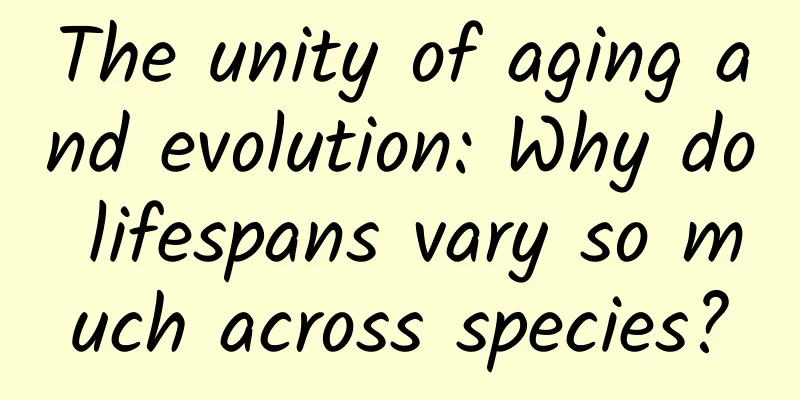The unity of aging and evolution: Why do lifespans vary so much across species?

|
We can understand aging from an evolutionary perspective to explain the following questions: If evolution is the survival of the fittest, then what exactly does the gradual degeneration process of aging adapt to and what are the benefits? Why is there diversity in the issue of aging? There are currently several theories to explain the reasons, such as the mutation accumulation theory and the antagonistic pleiotropy theory, but there is no universal hypothesis in real-world biology. Aging is more like an evolutionary oversight, with different mechanisms behind it. Written by Drew Steele Translations | Zhang Wentao and Wang Xi Aging has plagued us since the dawn of humanity. We find it (almost) everywhere. From mammals like us to insects, plants, and even single-celled organisms like yeast, aging occurs. Aging appears to be a universal degenerative process in living things. This is not surprising - outside of biology, machines wear out and buildings fall apart over time. Why should life be immune to this? The question is, how do we reconcile aging with evolution? If evolution is all about survival of the fittest, then what exactly is the adaptation to, and what good is, of the gradual degeneration process of aging? Another big question is why there is such diversity in aging. The shortest-lived adult insect known is a mayfly, where females emerge, mate, lay eggs, and die in five minutes, while the longest-lived vertebrate (one with a backbone, like us) is the Greenland shark, with the oldest known female estimated to be 400 years old. Why do mice live only a few months, chimpanzees can live for decades, and some whales can live for hundreds of years? If aging is a process of life loss, why do the time scales of aging vary so much in different animals? The “evolution of aging” may sound like a paradox, but fortunately, we can still understand aging from an evolutionary perspective. Understanding this is more than just an exercise in evolution class (although that’s an attractive idea) or an attempt to reconcile two apparently divergent laws of biology (although that’s very important). More importantly, it gives us a deeper understanding of what aging is, what it isn’t, and how we can cope with it. Statistical definition of aging We first need to redefine what we mean by aging. Rather than presenting a biological definition of aging, we will attempt to define aging from a statistical perspective: aging is an increasing risk of death over time. Whether it is animals, plants, or other life forms, as they age, their risk of death increases, which is a process called aging; some special creatures, such as the Galapagos giant tortoise, do not age, because their risk of death remains constant. We clearly see that the risk of death in humans doubles for every 8 years of age, which statistically defines our aging rate. We can use this statistical definition to understand aging at the evolutionary level. Whether it is wrinkles on the face or an increased risk of heart disease, it is a manifestation or form of what comes with it. Some people are used to explaining aging in terms of the most basic physics rather than biological processes. "It's the second law of thermodynamics, entropy always tends to increase," in other words, things in this world will become chaotic and eventually collapse over time. However, this argument is flawed because it ignores a key premise of the second law of thermodynamics: it only applies to closed systems. If you are isolated from your environment and there is no exchange of matter and energy, then all you can do is postpone your fate, but not change it. In the end, dust will return to dust, and dust will return to dust. But if you are not isolated, you can take in energy from your surroundings and use it to inject new sources of power into your life. This may sound profound, but it is actually simple - because animals can get energy from eating and plants can convert sunlight into food, they are free to use this energy for various biological and biochemical processes, recycling, removing or replacing key components that are degrading. Animals, far from being bound by the oversimplified laws of thermodynamics, have evolved incredible self-repair abilities. Some, like salamanders, can completely regenerate a limb after losing it. It sounds like a party trick, but it happens all the time in all living things, including you, at a microscopic scale. When cells, their organelles, and the molecules that make them up break down or become broken down, our bodies quickly clear out the damaged structures and build new ones to replace them. Countless molecular machines work nonstop to maintain the integrity of the organism, removing damaged cells that have become “junk.” In the human body, this process continues for decades, day after day, and in theory, the efficiency of this repair behavior should not decrease over time, as long as energy intake is guaranteed. So why can't evolution continue to improve the efficiency of this self-repair so that the body will always be perfect? What drives aging? Alfred Russel Wallace was probably the first scholar to propose an evolutionary theory of aging. Between 1865 and 1870, he wrote in his notebooks that old animals "consume nutrients... an injury to their offspring," and that in an environment where food is limited, too many old animals would be scrambling around and consuming limited resources, making it more difficult for their offspring to survive. "Thus, natural selection has eliminated the old animals," Wallace concluded. It is more appropriate for animals to have a lifespan, so that their offspring can grow and continue to reproduce. A biologist named August Weismann independently proposed a similar theory, that the lifespan of an organism is limited by the "necessities of the species as a whole." Any theory based on the idea that the good of the group is superior to the good of the individual, including this one, has a fatal flaw. This argument is called group selection, in which animals act in the best interests of their group (usually the species) rather than their own. But it is actually very problematic because group selection requires an uneasy truce. If every animal knew and agreed that getting older was in the best interests of the species as a whole, it would be a win-win situation, but if just one individual was born with a gene for slightly longer life, this delicate balance would be upset. The "selfish" animal with the slightly longer life gene would outcompete the altruistic one: when most of the group died, freeing up resources for the rest of the group, the "selfish" animal would consume those resources and live longer—perhaps long enough to have one more offspring before it died. This extra offspring would spread the gene for longevity through the population, and eventually the animal with the "selfish" gene for longevity would come to dominate the group. Over time, as this continued for several generations, even more "selfish" individuals would emerge, living longer and becoming more competitive. At this point, aging is no longer an evolutionary advantage: even though longer lifespans for individual animals are detrimental to the population as a whole, evolution actively selects for strategies that combat aging. The idea of group selection has fallen out of favor in modern evolutionary biology because it inevitably happens no matter what trait you select for. Selfish genes almost always create selfish creatures, which use their selfish genes to outcompete their altruistic peers and eventually become dominant in the group. So, rather than a noble act of utilitarian calculation for the benefit of the species as a whole, we now think of aging as something that is not the intention of natural selection, but rather the result of its neglect. This regulation of evolution is achieved through the risk of death caused by external factors such as infectious diseases, predators or falling off cliffs (collectively referred to as exogenous death). In contrast, endogenous death is the result of something going wrong with the animal's own body, such as cancer. The importance of exogenous death was recognized by evolutionary biologists in the mid-20th century, which laid the foundation for our current understanding of how aging evolves. Let's take an example of animals living on an island. Life on an island is risky, and suppose there is 10% exogenous mortality from predators and infectious diseases each year, meaning 10% of the animals die each year. So, 90% of these animals will have a chance to see their first birthday, and 81% will have a chance to see their second birthday... but only 35% will make it to age 10, and less than 1% will make it to age 50. Although you are unlikely to find animals older than that, there is still no true aging in this case. This is because our definition of aging is that the risk of death increases over time, but here the risk of death is a constant 10%. The animals here have zero endogenous mortality, no matter how old they are. We always refer to evolution as "survival of the fittest," but evolution is about more than just survival. Reproduction is even more important. From an evolutionary perspective, there is only one thing on a life's list: having children. Animals with mutations that enhance their reproductive ability mean they will have more children, and these offspring will also carry mutations that enhance their reproductive ability. After several generations of reproduction, they will have more children than animals without mutations, and gradually dominate the population. Let's return to our example of the danger island, this time considering the reproduction of animals. Even though these animals can reproduce throughout their lives, by far most reproduction will occur when the animals are young, because most animals die before they reach true physiological old age. Since most reproduction occurs when animals are young, factors that affect reproduction in old age are not very meaningful. Doubling an animal's reproductive capacity at age 50 does not give it any evolutionary advantage, because it may not live long enough to double its number of offspring. Conversely, an animal that gains a reproductive advantage at age 3 may still be alive and reproducing heavily for another 3 years. This advantage means that it will have more offspring, a huge evolutionary advantage. Improved reproductive capacity could take many different forms, such as theoretically having more pups per litter, shorter intervals between births, larger beaks to get more food and raise more offspring, or better survival to have more children. In any case, the impact of conferring an evolutionary advantage on young animals is huge because they are likely to survive and pass on those advantageous genes to the next generation. In contrast, evolution has a harder time affecting older animals because their expected survival time is too short to have offspring to pass on their genes. This is the real root cause of aging - evolution cannot keep old animals resilient because they are unlikely to have children. Remember, all of this has nothing to do with aging itself, but simply because there are fewer old animals because of exogenous death factors. So, it is a bit counterintuitive that the key factor driving the evolution of aging is that animals die from risks other than aging, but this is exactly what we see. mutation accumulation theory The next question is how this negative regulation of evolution is achieved. First of all, we have to mention a mechanism called "mutation accumulation theory". As we all know, DNA is the genetic code in organisms, and the establishment and maintenance of life activities rely on the genetic information in DNA. Mutation is a change in the DNA sequence. From an evolutionary perspective, we are all mutated individuals. Although half of our DNA comes from our father and half from our mother, each of us generally carries 50 to 100 mutations in our DNA sequence, which is different from both the mother's DNA and the father's DNA. Most of these mutations have no effect. They exist inside our genomic DNA and will not have a substantial impact on our survival probability. There are also very few mutations that have positive or negative effects on life: mutations that have positive effects will increase the probability of survival or reproductive ability, and thus have a greater chance of being passed on to the next generation; mutations that have negative effects are just the opposite, and will be eliminated by evolution over time. If some random mutation causes an animal to spontaneously die at age 50, this may seem like a very bad disadvantage, but in reality it is not that bad, because more than 99% of the animals with this mutation will die from other factors before the mutation becomes lethal. Therefore, this type of mutation is likely to remain in the population for generations - not because it is a good mutation, but because the force of natural selection at an advanced age is not strong enough to eliminate this mutation. In contrast, if the mutation causes the animal to die at the age of two, when survival and reproductive capacity are high, evolution will eliminate this mutation very quickly. Because the force of natural selection is very strong at and before the reproductive age of an animal, animals with this mutation will be quickly eliminated by the "lucky ones" without the mutation. Therefore, even if some mutations have adverse effects on life, they can accumulate in a population as long as they take effect only after the animal is old enough and has reproduced. According to this theory, aging is not an adaptation of the animal population to the environment, but the result of evolution's inability to deal with such mutations. A perfect example of this theory is Huntington's disease, which inspired mathematician and biologist JBS Haldane to propose this explanation that the "power" of natural selection decreases as individuals age. Huntington's disease is a neurological disease caused by a single gene mutation. Patients usually develop symptoms between the ages of 30 and 50 and die about 15 to 20 years after diagnosis. As mentioned above, the life expectancy of prehistoric humans was between 30 and 35 years old. From an evolutionary perspective, Huntington's disease, which only shows symptoms at the age of 40 and causes the risk of death after the age of 55, did not have much impact on the human life span at that time. In such a period far away from modern civilization, a 30-35-year-old person may have already had several children, and his reproductive life span was not long. Even in modern society, Huntington's disease patients are likely to have given birth to their own children before dying of the disease. Therefore, even if Huntington's disease is a fatal neurological disease, it is still inherited in small numbers in the human population to this day. Huntington’s disease is an example of a single gene mutation causing very bad adverse effects in an individual’s post-reproductive years, and it’s a good example of how mutations with lethal effects can accumulate unexpectedly in human populations. However, while the single gene example is easier to illustrate, in the normal aging process, what’s more likely to happen is the cumulative effect of multiple different genes, which may act alone or in combination to reduce our chances of survival after we reproduce. Some lethal mutations occur randomly in the gene pool, just to allow us to reproduce first before playing a life-ending role, thus escaping evolution’s natural selection. Taken together, these imperfect genes that have been overlooked by evolution are the real determining factors behind some of the processes that make us age. But aging is not a random event. In addition to being indifferent to your health after you have completed reproduction, evolution will do something even crueler: trade your future health for stronger reproductive ability. Evolution can trade running ability, height, hair color, everything else in exchange for more offspring. Whether you move faster or slower, taller or shorter, grayer or more colorful, longer or shorter life, evolution doesn't care, as long as it can improve the overall reproductive success rate, evolution will accept it. The balance between life and death So how does evolution reconcile the trade-off between the decline in animal survival or even death and the ability to reproduce? The answer is that genes themselves often have multiple characteristics. Modern genetics has discovered that genes do not exist in a kind of "splendid isolation" and do not encode only one characteristic of a living organism. They often have different functions at different times of development and in different parts of the body, and interact with each other to form a complex network. When you hear someone talk about a gene producing multiple complex characteristics, you may not believe it. Even a simple feature like eye color is actually controlled by many different genes. These genes also have multiple other functions, such as affecting the color of hair and skin, and may even play a role in other life activities in ways we are not aware of. Biology calls the multifunctionality of a single gene "gene pleiotropy." Another theory about evolution and aging is called "antagonistic pleiotropy." Genes have multiple effects that help reproduction early in life but cause bad effects as animals age. Suppose that an island population develops a mutation that increases the risk of death after age 30, but causes it to reach reproductive maturity a year earlier than it otherwise would. Carriers of this mutation will rapidly increase in number compared to animals without the mutation. The increased risk of survival after age 30 is negligible compared to the greater reproductive capacity. This reproductive advantage will accumulate to younger animals, giving most of them an extra year of reproductive time while they are still alive. Occasional mutations that cause negative effects later in life will accumulate genetically in the population, according to the mutation accumulation theory, but there is more to it. Such mutations will be actively selected by evolution if they promote reproduction for the entire population. How many years of old age would you want to trade for the vigor of youth? Evolution doesn't care about the inexperience of the young or the wisdom of the old; its answer to this question is to optimize over the generations of life to maximize the reproductive success of the population. The behavior of "antagonistic pleiotropic" genes is a bit abstract. Why would reaching reproductive maturity faster lead to an organism's early death? To put it in context, we introduce our third and final evolutionarily relevant theory of aging, the so-called "disposable somatic theory." It stems from a principle that applies to nature and everyday life: there is no such thing as a free lunch. Recall how we refuted the thermodynamic explanation of aging: animals and plants can obtain energy from the environment to repair and maintain their bodies. From a purely physical point of view, we don't need to experience aging at all, as long as we are willing to sacrifice some of the energy we obtain (such as through long periods of hunting and gathering) to fight the consumption of time and entropy. Whether it is biological or mythological "immortality", there is always a price to pay. In biology, immortality does not require foolish sacrifices to the gods, but requires constant maintenance of the body. Maintaining the body requires energy, and growing muscles to escape from predators, building immune systems to fight diseases, or reaching sexual maturity faster to reproduce before death also requires energy. The idea behind the disposable somatic cell theory is that energy is limited and needs to be allocated between different tasks, including reproduction and fighting aging. Somatic cells are a general term used by biologists for cells in the body other than reproductive cells, such as eggs and sperm. From an evolutionary perspective, your body is just a container for reproductive cells, such as sperm, or your offspring. This perspective may be frustrating, but the theme at hand is that reproductive success equals evolutionary success. Your somatic cells are expendable because your offspring are what matters. This means that looking after germ cells is a top priority, so all organisms give them a high priority in terms of energy expenditure. It is not clear how much energy is spent on maintaining body cells. As with previous theories, what evolution really cares about is whether you can survive long enough to pass on your genes to future generations. If an organism has a limited amount of energy to expend, would evolution prefer to spend that energy on maintaining its physical condition or on rapidly reproducing offspring? Evolution will calculate the external risk of death for the entire group. If that number is high, evolution will tend to choose the latter, ensuring that your children outlive you while your useless body decays over time (assuming you live to see that day). Therefore, one way antagonistic pleiotropy is to reduce the level of somatic maintenance through mutations, allowing you to grow faster when you are young, but when your imperfect body enters old age, problems in somatic maintenance will appear one by one. Comparing the very different life spans and reproductive strategies of different animals can help us better understand how these theories work. Given the close relationship between evolutionarily relevant aging and extrinsic mortality risk, it is expected that animals living in more dangerous environments will reproduce faster and more efficiently, and once they have finished reproducing, they will age more quickly. Comparisons of mice (which don't live more than two years in the wild) and whales (one of the longest-lived mammals) also reveal one of the most famous findings in the biology of aging: the bigger an animal is, the longer it tends to live. Why do big people live longer? We've come up with many different explanations (or we've reversed cause and effect, since it takes longer to grow big), but one simple but important factor is that big people are harder to kill or eat. In fact, studying species that do not conform to this size-lifespan correlation is more helpful in clarifying the relationship between aging and external mortality risk. In order to be as fair as possible, we selected mammals of similar size: house mice weighing about 20 grams and mouse-eared bats weighing nearly 30 grams as adults. Mice in captivity can live for 3 to 4 years, while the longest recorded lifespan of mouse-eared bats is 37 years. What is the secret behind the huge difference in lifespan? One obvious difference is that bats can fly while mice cannot. It is not the pleasure of flying that makes bats live longer, but being away from the ground keeps them away from predators. In the air, the threats to the living environment are much less, and the external mortality risk of bats is naturally much lower than that of mice. This means that in the process of evolution, mutations are more difficult to accumulate, antagonistic pleiotropic genes are eliminated by the power of natural selection, and the advantages of wasting disposable somatic cells are gradually lost. So biologists can breathe a sigh of relief that aging, as it relates to evolution, is not that complicated. It may sound ironic that animals living in endangered conditions have escaped natural selection for genes that optimize their second half of life, and instead evolved aging. There is just one small problem: simply understanding these theories makes us feel that all species should age. So how do we explain animals like the Galapagos giant tortoise, which seem to be insensitive to aging? We have finally completed a closed loop of reasoning: evolution and aging are compatible, so how can there be animals that do not age? Why do some species barely age? Different evolutionary strategies of species may lead to unexpected aging trajectories. Female fish become larger, stronger and more fertile as they age. Large fish can escape predators more easily than small fish, which means that the external risk of death of fish is not constant, but decreases with age. At the same time, older fish can produce more and better eggs. In some extreme cases, the number of eggs laid by older fish can reach dozens of times that of young fish. These underwater female fish are called BOFFFF: big, old, fat and fertile female fish. BOFFFF is crucial in many types of fish populations, because the reproduction of the population is often not maintained by the few eggs laid by a young fish, but by a small number of BOFFFFs laying a large number of eggs quickly. This reproductive strategy overturns the premise of our thought experiment that natural selection produces aging. The survival rate and fertility of older fish are improved at the same time, giving these BOFFFF a great advantage in passing on their genes. Their survival is evolutionarily important, which makes the influence of natural selection last longer and cover adult fish. Perhaps evolution has calmly calculated that maintaining the fish's somatic cells is a good deal, and the damage to BOFFFF by the accumulation of mutations or "antagonistic pleiotropy" is not so easy to accept. Therefore, the possible outcome of fish evolution is that their overall risk of death does not increase with age - in other words, aging is negligible. But it also suggests that overfishing is particularly harmful to BOFFFF, which will cause some serious unnatural selection. The reduction of older reproductive females in the group will stimulate early reproduction of young fish, which may lead to genetic mutations that make the species begin to age. Turtles and fish may have similar reasons for resisting aging: Older female turtles are protected from many external threats (thanks to their hard shells) and are very fertile. Natural selection has every reason to keep them alive, and as a result, they don't seem to age. In reality, aging is more like an evolutionary oversight, with different mechanisms behind it: the accumulation of mutations that escape natural selection, which make organisms less healthy in old age; antagonistic pleiotropic genes that maximize reproductive success in youth without paying attention to possible misfortunes after reproduction; and our bodies prioritizing reproduction over maintaining the health of somatic cells. Therefore, we cannot expect that there must be a single cause behind aging. Instead, we should think of aging as a complex set of processes that occur simultaneously but are only partially connected. About the author/translator About the Author: Andrew Steele, a computational biologist, PhD in physics, and researcher at the Francis Crick Institute in London, switched from physics to biology because he realized that the ultimate suffering of humans comes from aging, and he wants to change all that. About the Translator: Zhang Wentao, PhD in Microbiology, is a senior engineer at the Computer Network Information Center of the Chinese Academy of Sciences. He is a senior supervisor of the official science popularization micro-platform "Science Academy" of the Chinese Academy of Sciences, and a senior editor of the "China Science Popularization Expo", a science popularization cloud platform of the Chinese Academy of Sciences. He has been engaged in the planning and creation of science popularization content and the operation of science popularization platforms for a long time. Wang Xi, PhD in Biochemistry and Molecular Biology, is an associate researcher at the Institute of Biophysics, Chinese Academy of Sciences. He is a member of the Youth Innovation Promotion Association of the Chinese Academy of Sciences. He conducts research in the field of protein homeostasis and human health and has won the silver medal of the Sixth China Science Writers Association Outstanding Science Works Award (Youth Short Science Works Category). This article is authorized to be selected from Chapter 2 "The Origin of Aging Problems" of "The Science of Ageing" (CITIC Press·Nautilus, April 2023), with some deletions and subheadings added by the editor. Special Tips 1. Go to the "Featured Column" at the bottom of the menu of the "Fanpu" WeChat public account to read a series of popular science articles on different topics. 2. Fanpu provides a function to search articles by month. Follow the official account and reply with the four-digit year + month, such as "1903", to get the article index for March 2019, and so on. Copyright statement: Personal forwarding is welcome. Any form of media or organization is not allowed to reprint or excerpt without authorization. For reprint authorization, please contact the backstage of the "Fanpu" WeChat public account. |
<<: Chinese scientists have made a breakthrough! Solar cells that look like paper are here
>>: AI fraud is around the corner, how can we prevent it?
Recommend
Such a cute bird! The parrot tears the paper and tries to insert "feathers" to turn into a peacock?
Not long ago, a funny video about a parrot shot b...
The red envelope subsidy method is no longer effective. Try using prospect theory to promote and attract traffic!
In the past few years of the Internet 's rapi...
Tofu contains high levels of estrogen. Will men who eat too much become effeminate and women who eat too much get cancer? The truth is out.
Tofu contains high levels of estrogen. Will men w...
Universal template for event planning and promotion!
Event planning is a tedious and detailed job. Eve...
How to write copy for new products to stimulate users to buy?
After several months of all-night overtime work b...
BA.5 has been introduced into China! Academician Zhang Boli: The most contagious strain known so far
"The BA.5 strain is not only the most contag...
IFBB Sports Nutrition Lin Daowei Carbohydrate Cycling Diet
IFBB Sports Nutrition Lin Daowei Carbohydrate Cyc...
Behind Midea's rare absence from AWE: the battle for upgrading among home appliance giants has begun
Recently, AWE2023 (China Home Appliances and Cons...
6 Lessons for Rapidly Scaling Applications
While the COVID-19 pandemic is still having an ad...
How does "Meipian", which has 80 million users, conduct content operations?
Meipian's slogan is to record the beauty and ...
Comment: American inventions plus Chinese manufacturing plus the global market are the future trend
The inventor in our impression is someone like Ed...
Community operation, how to improve activity and conversion rate?
In this article, the author will talk about how t...
How much does it cost to develop a women's clothing mini program in Taizhou?
The factors affecting the quotation of Taizhou wo...
Microsoft releases ASP.NET 5 version roadmap
[[141377]] The ASP.NET versions released with Vis...









